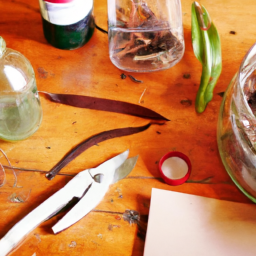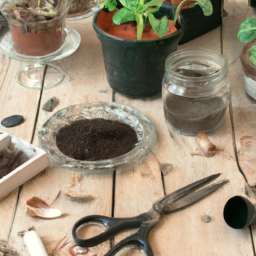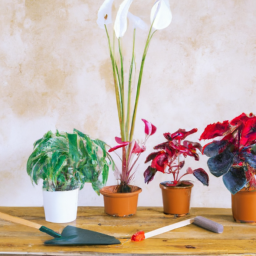
As spring approaches, many gardeners are eager to start propagating their favorite plants to expand their garden and share with friends. The art of propagating plants in spring is a rewarding and cost-effective way to grow new plants from existing ones. Whether you’re a seasoned gardener or just starting out, learning the tips and techniques for successful propagation can help you create a thriving garden filled with beautiful blooms and lush greenery. In this blog post, we’ll explore the ins and outs of propagating plants in spring, from choosing the right plants to mastering different propagation methods. So grab your gardening tools and let’s dive into the wonderful world of plant propagation!
Propagating Plants in Spring: An Introduction to Techniques and Tips
The Basics of Plant Propagation
Understanding Plant Propagation
Plant propagation is the process of creating new plants from existing ones. This can be done through various methods such as seed propagation, cutting propagation, division, and layering. In spring, plants are actively growing and are more likely to successfully propagate, making it an ideal time to start your propagation journey.
Choosing the Right Plants to Propagate
When selecting plants to propagate, it’s important to choose healthy and disease-free specimens. Look for plants that are actively growing and have strong root systems. Some popular plants to propagate in spring include herbs, succulents, and flowering perennials.
Essential Tools for Plant Propagation
Before you start propagating plants, make sure you have the right tools on hand. Some essential tools for plant propagation include sharp scissors or pruners for taking cuttings, rooting hormone to encourage root growth, and well-draining potting mix to plant your cuttings in.
Propagation Techniques
Seed Propagation
Seed propagation is the process of growing plants from seeds. To start, choose high-quality seeds and sow them in a seed-starting mix. Keep the soil consistently moist and provide adequate light and warmth for germination. Once the seedlings have developed true leaves, they can be transplanted into individual pots.
Cutting Propagation
Cutting propagation involves taking a cutting from a parent plant and encouraging it to develop roots. To propagate plants from cuttings, select a healthy stem with at least two nodes and remove any lower leaves. Dip the cut end in rooting hormone and plant it in a pot with well-draining soil. Keep the soil moist and provide indirect light until roots develop.
Division and Layering
Division is a propagation method used for plants that have multiple stems or clumps. Simply divide the plant into sections, making sure each section has roots attached. Plant the divisions in individual pots and water them well. Layering is a method where you encourage a stem to develop roots while still attached to the parent plant. Once roots have formed, you can separate the new plant from the parent.
Tips for Successful Plant Propagation
Provide Adequate Light and Water
Plants need light to photosynthesize and grow, so make sure your propagated plants are placed in a location with adequate sunlight. Additionally, water your plants regularly, but be careful not to overwater as this can lead to root rot.
Monitor for Pests and Diseases
Keep an eye out for pests such as aphids, mealybugs, and spider mites, as well as common plant diseases like powdery mildew and root rot. If you notice any signs of pests or diseases, take action immediately to prevent them from spreading to your other plants.
Be Patient and Stay Consistent
Propagation can be a slow process, so be patient and give your plants time to establish themselves. Consistency is key when it comes to caring for propagated plants, so make sure you stick to a regular watering and feeding schedule to help your plants thrive.

Understanding the Art of Propagating Plants in Spring
Why Propagate Plants in Spring?
Spring is the perfect time for propagating plants because this is when plants are actively growing and have an abundance of energy to put towards producing new roots and shoots. The longer days and warmer temperatures provide the ideal conditions for plants to establish themselves quickly and thrive. By propagating plants in spring, you give them the best chance of success as they have the entire growing season ahead of them to establish strong root systems and develop into healthy, mature plants.
When propagating plants in spring, it’s important to choose the right plants to propagate. Look for plants that are actively growing and showing signs of new growth, as these are the plants that are most likely to successfully root and establish themselves. You can propagate a wide range of plants in spring, from herbaceous perennials and shrubs to trees and vines. Just make sure to choose plants that are suited to your climate and growing conditions to ensure their success.
Propagation Techniques for Spring
There are several techniques you can use to propagate plants in spring, depending on the type of plant you are propagating and your level of experience. One of the most common methods of propagation is stem cutting, where you take a cutting from a healthy plant and encourage it to develop roots and grow into a new plant. To propagate plants from stem cuttings, choose a healthy, non-flowering stem from the parent plant and cut it just below a leaf node. Remove any leaves from the lower half of the cutting and dip the cut end in rooting hormone before planting it in a well-draining potting mix. Keep the cutting moist and in a warm, bright location until roots develop, then transplant it into a larger container or into the garden.
Another popular method of propagation is division, which is commonly used for herbaceous perennials and grasses. To propagate plants by division, dig up the parent plant and carefully separate the root ball into smaller sections, each with its own roots and shoots. Replant the divisions in a suitable location with well-amended soil and water them well to help them establish. Division is a great way to create new plants from existing ones and can help rejuvenate older plants that have become overcrowded or overgrown.
Layering is another effective propagation technique that can be done in spring. Layering involves bending a flexible stem to the ground and burying a portion of it in soil, where it will develop roots and eventually grow into a new plant. To propagate plants by layering, choose a healthy, flexible stem and make a small incision in the bark where you want the roots to form. Bury the wounded portion of the stem in soil and secure it in place with a stake or rock. Keep the layered stem moist and wait for roots to develop before cutting it free from the parent plant and transplanting it into a new location.
Tips for Successful Plant Propagation
To ensure successful plant propagation in spring, there are a few key tips to keep in mind. First, make sure to choose healthy, disease-free plants for propagation, as sickly or stressed plants are less likely to root and establish themselves. It’s also important to use clean, sharp tools when taking cuttings or dividing plants to prevent the spread of disease and ensure clean cuts that heal quickly. Additionally, provide the right growing conditions for your propagated plants, including well-draining soil, adequate moisture, and the appropriate amount of sunlight for the plant species.
When propagating plants in spring, be patient and give your plants time to establish themselves before expecting rapid growth. It can take several weeks or even months for plants to develop roots and begin putting on new growth, so be patient and provide consistent care and attention to your propagated plants. By following these tips and techniques for propagating plants in spring, you can enjoy the satisfaction of creating new plants and expanding your garden with minimal cost and effort.

Mastering Propagation Techniques for Spring Plantings: Tips and Tricks
Understanding the Basics of Plant Propagation
When it comes to propagating plants in the spring, there are a few key techniques that every gardener should master. One of the most common methods of propagation is through stem cuttings. This involves taking a cutting from a healthy plant and encouraging it to grow roots in order to create a new plant. Another popular method is division, which involves separating a mature plant into smaller sections and replanting them to create new plants.
In addition to stem cuttings and division, layering is another effective propagation technique. This involves bending a branch of a plant down to the ground and covering it with soil so that it can develop roots. Once roots have formed, the new plant can be separated from the parent plant and transplanted to a new location.
Propagation can also be done through seeds, although this method is typically more time-consuming and requires more patience. However, growing plants from seeds can be a rewarding experience, as it allows you to witness the entire life cycle of a plant from start to finish.
Tips for Successful Plant Propagation
When propagating plants in the spring, it’s important to choose the right plants to propagate. Look for healthy, disease-free plants with strong growth habits. Avoid plants that are stressed or struggling, as they may not propagate successfully.
It’s also important to choose the right time to propagate your plants. Spring is generally a good time for propagation, as plants are actively growing and are more likely to root successfully. Make sure to take your cuttings or divide your plants on a mild, overcast day to minimize stress on the plants.
Proper care and maintenance are crucial for successful plant propagation. Make sure to provide your plants with the right growing conditions, including adequate sunlight, water, and nutrients. Keep a close eye on your plants and make adjustments as needed to ensure they are thriving.
Techniques for Propagating Specific Types of Plants
Different types of plants require different propagation techniques. For example, herbaceous plants like lavender and mint are typically propagated through stem cuttings, while woody plants like roses and hydrangeas are often propagated through division or layering.
When propagating herbaceous plants, make sure to take cuttings from healthy, non-flowering stems. Remove any leaves from the lower half of the cutting and dip the cut end in rooting hormone before planting it in a well-draining potting mix.
For woody plants, division can be a good option for plants that have become overcrowded or are not flowering as well as they should. Simply dig up the plant, separate it into smaller sections, and replant them in a new location.
By mastering the art of plant propagation, you can expand your garden and create beautiful new plants to enjoy for years to come. With the right techniques and a little patience, you can successfully propagate a wide variety of plants in the spring and watch them thrive in your garden.
I’ll leave you with these final thoughts
Spring is the perfect time to start propagating plants and expanding your garden. Whether you’re a seasoned gardener or a newbie looking to try your hand at plant propagation, there are several tips and techniques that can help you succeed. One of the most common methods of propagation is through stem cuttings, where you take a cutting from a healthy plant and encourage it to grow roots and become a new plant. Make sure to use sharp, clean tools when taking cuttings and choose a healthy, disease-free plant to ensure success.
Another popular method of plant propagation is through division, where you separate a plant into multiple parts to create new plants. This is a great way to rejuvenate older plants and create more plants for your garden. Make sure to divide plants when they are actively growing and choose plants that are suited for division, such as perennials and ornamental grasses. With a little patience and practice, you can master the art of propagating plants in spring and enjoy the satisfaction of watching your garden grow and flourish.
Top FAQs:
Q1: When is the best time to propagate plants in spring?
A1: The best time to propagate plants in spring is typically during the early to mid-spring months when the weather is warming up and plants are actively growing. This is when plants are most likely to successfully root and establish themselves.
Q2: What are some tips for successful plant propagation in spring?
A2: Some tips for successful plant propagation in spring include choosing healthy parent plants, using a well-draining potting mix, providing adequate sunlight, and keeping the soil consistently moist but not waterlogged. It’s also important to regularly monitor the progress of your propagated plants and make any necessary adjustments.
Q3: What are some common techniques for propagating plants in spring?
A3: Some common techniques for propagating plants in spring include stem cuttings, leaf cuttings, division, layering, and seed propagation. Each technique has its own specific requirements and success rates, so it’s important to choose the method that is best suited to the plant species you are propagating.
Q4: How long does it take for propagated plants to establish themselves in spring?
A4: The time it takes for propagated plants to establish themselves in spring can vary depending on the plant species and propagation method used. In general, it can take anywhere from a few weeks to several months for roots to develop and for the plant to establish itself in its new growing environment.
Q5: What are some common mistakes to avoid when propagating plants in spring?
A5: Some common mistakes to avoid when propagating plants in spring include overwatering, using poor quality potting mix, not providing enough sunlight, and not monitoring the progress of your propagated plants. It’s important to research the specific needs of the plant species you are propagating and to follow best practices to ensure successful propagation.

James Wong is a renowned ethnobotanist, plant scientist, and local television presenter. With a passion for demystifying plant science, he is known for translating complex botanical concepts into practical advice for everyday plant enthusiasts. James’s expertise spans from traditional gardening to cutting-edge plant technologies, making his insights accessible and informative.


